The other day, in the bike rack of my daughter’s school, I noticed a very practical children’s bike. It had everything a bike needs to be used as a real transportation vehicle — a chain-guard, generator lights front and rear, a rack, a frame pump, full-coverage fenders, and a bell.
Upon further inspection, my hunch about its provenance was confirmed. It was a Pegasus brand bike that was purchased (based on a sticker I saw on the fender) at a bike shop in Germany.
The bike reminded me of a photo sent to me by a reader a few months ago who has just returned from a trip to Dresden. They were floored when they came across this fully-decked out, practical kids city bike:
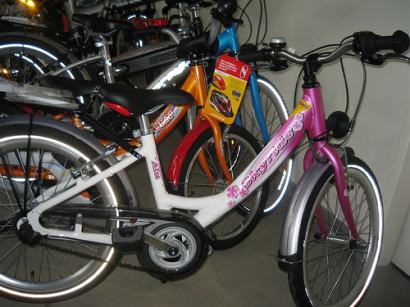
(Photo: Greg Raisman)
At this point, you might be wondering what’s available on the U.S. market for aspiring and youthful everyday bikers.
Here’s the closest thing I could find on the U.S. website of Giant Bicycles, one of the largest bike makers in the world:
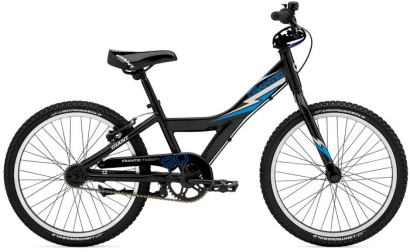
A quick search of WalMart.com, where millions of Americans shop for bikes, revealed something similar to Giant’s offering (in features, not in quality of course).
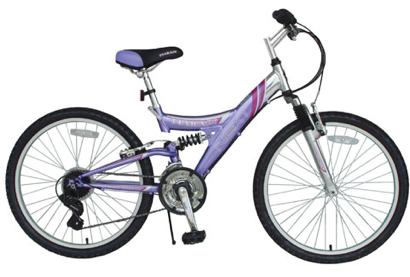
Why the lack of good bike options for kids in the U.S.? One (of many) reasons might be a fact I learned just a few days ago — that in this country there are still hundreds of schools and dozens of school districts that prohibit kids from riding to school.
Yes, you read that right. In scores of schools across the country, kids and their parents are told that they are not allowed to bike to school.
I asked former BTA Safe Routes to School chief and current state network manager for the Safe Routes to Schools National Partnership for more about this ridiculous policy.
< ?php if (function_exists('dfrad')) { echo dfrad('ad_225x225'); } ?>
Ping says the “no bike riding” policy (which is rarely put into writing) usually comes from principals but also comes from school boards. The reason, he says, is a concern for the safety of the kids.
“It’s a way of thinking in the US, where people think the automobile is the only serious form of transportation, especially for kids.”
— Robert Ping with the Safe Routes to Schools National Partnership
“You can imagine the fear it puts into parents,” says Ping, “when these community leaders (principals and school board members) say it’s too dangerous to ride a bike”.
Pings calls such policies nothing more than a “knee-jerk reaction” from people who don’t ride. “All they see are the big, arterial streets they drive on, so these put these policies into place without giving it much thought.”
“It’s a way of thinking in the US, where people think the automobile is the only serious form of transportation, especially for kids.”
I’m not saying better choices in kids bikes is all we need to reverse this type of mindset, but it would sure be helpful if more U.S. bike companies took kids bikes more seriously (like they’re finally starting to do with adult bikes).
— For further reading, check out this story from the Portland Tribune yesterday about how some Portland schools can’t afford to improve traffic safety around their schools.


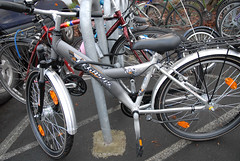
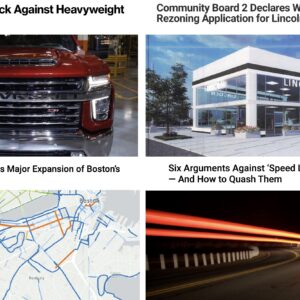
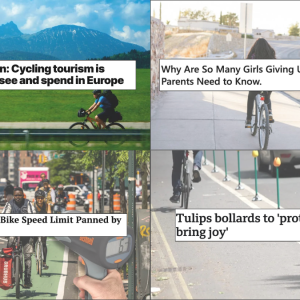

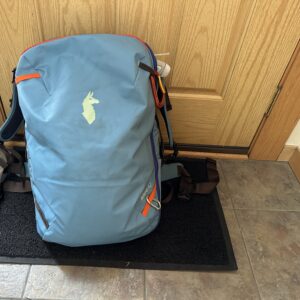
Thanks for reading.
BikePortland has served this community with independent community journalism since 2005. We rely on subscriptions from readers like you to survive. Your financial support is vital in keeping this valuable resource alive and well.
Please subscribe today to strengthen and expand our work.
Growing up, I rode to middle school and high school every chance I could. These new so-called ‘rules’ for young riders could be easily overturned via lawsuit.
“The right to travel is a part of the ‘liberty’ of which the citizen cannot be deprived without due process of law under the Fifth Amendment. If that “liberty” is to be regulated, it must be pursuant to the law-making functions of the Congress. . . . . Freedom of movement across frontiers in either direction, and inside frontiers as well, was a part of our heritage. Travel abroad, like travel within the country, . . . may be as close to the heart of the individual as the choice of what he eats, or wears, or reads. Freedom of movement is basic in our scheme of values.”
– Justice William O. Douglas
We bought a new bike for our daughter. She tried out the girls pink bike and it fit well and she was happy. We of course wanted something a bit more gender neutral so her younger brother would accept it as a hand down. Well she was cool with that until she saw that the boy’s bike didn’t have a bell and the girls bike did. Apparently it is not unusual for girls bike to come with a bell and the same bike with a different paint job for a boy has none. The nice salesman took it off the girls bike and threw it in with the other.
My question is, is this just a kid bike issue? Most bikes still don’t come with lights, fenders, rack or a bell. Ski shops give package deals for kids buy skis, and bindings get a discount on Helmet goggles etc. do any of the bike shops do this?
reminds me of a Yehuda strip.
http://www.yehudamoon.com/index.php?date=2008-04-29
Yeah, I want to know too. We are soon going to be shopping for a new bike for my son and I would like it to be as complete and cool as possible. Where should we buy it.. knowing he will outgrow it in 3 years. He will have this bike from 6-10 at the most I would think.
Here’s one with fenders and a chain guard from Jamis:
http://www.jamisbikes.com/usa/thebikes/youth/09_capri24_bk.html
A nice-looking one from Marin (fenders, chain guard)
the Marin link, sorry:
http://www.marinbikes.com/2009_html/us/spec_pageLocal.php?serialnum=789
Maus your article blends a lot of very different issues together….school board policy…product marketing and development…product availability…etc…and they’re not necessarily all connected.
welcome to living in a litigenous society…schools are forced to provide safe transport for kids from their homes to school property. Schools also have to establish policy that works for all kids in public elementary or secondary education…a 17 year old would probably be fine riding a bike alone from home to school…a 12 year old with little comprehension of traffic patterns, parents who don’t care either way or don’t have the time to ride with them? Probably not. Policy has to be set by school boards for all students, under their protection, equally.
long live the school bus…
Actually, these things are pretty interconnected in my point of view.
Me being a European, your statement’s about 12 yr olds not being able to ride in traffic sounds very strange – they do here on the other side of the pond all the time.
But, ah yes, safety. Well, bikes are dangerous of course, for an American, fine. We here rather consider weapons to be dangerous… (how’s that for another mix of perspective?). Please note, I don’t wanna troll, just tell you: Yes, it really is a thing with lots of sides to it – And I was quite fond of it for this article to blend them together.
Meh.
I am a dual national EU citizen and I have to laugh at your statement. From my perspective Europe is incredibly backwards when it comes to sustainability and resource use. I would also love to see a comparison of cycling in Portland with the top bicycle cities in europe on equal footing. Our ACS statistics in the USA only count the trips of individuals who make more than 50% of their trips by bike. Mixed use bike commutes, trips to stores, and trips to restaurants do not count.
What a great post. As a non-parent, I must admit this is an issue I would have never even considered. It is damn near impossible to find adult bikes with those features in our region let alone kids bikes.
“Maus your article blends a lot of very different issues together…and they’re not necessarily all connected.”
I know bahueh. thanks.
I realized that but figured I wanted to share the thoughts anyways.
For what it’s worth, here’s the email I sent to Jonathan a few months back…
“I have decided that this is my favorite commuter bike ever. http://www.flickr.com/photos/gregraisman/1174130509/in/set-72157601655124492/
I took the photo in Cologne, Germany. This bike is meant for a three or four year old to be able to ride. It has a generator for the big front and rear lights, road worthy tires, a real chain guard, a rack, fenders, a comfy seat, a bell, 3 speeds, and a kickstand. It’s basically my ideal commuter bike for someone half my height (and I’m short).
The person who rides this bike has a lot more independence, responsibility, and see more of where they live than many of my neighbors who are the same age. They live in a city where ice cream is the local specialty, but obesity isn’t an epidemic [I’m serious, Cologne has more ice cream shops than Portland has coffee shops]. They also live in a place with very safe, comfortable, slow, multi-modal, beautiful streets. Streets so safe that three-year-olds who want to ride for transportation actually have commuter bike options.”
We bought our daughter a Jamis Capri (used) a few years ago. It only has a front fender, a situation I’m planning of rectifying soon. (I saw a pink fender at Revolver yesterday!)
What a timely article. I’ve been daydreaming about opening a kid’s only bike shop someday…this is a bit of a kick in the pants to spend some more time on the idea!
Anyway, just the other day a draft policy came across the Safe Routes listserv for a school in New Jersey. Among other wonderful policy changes there are some incredible nuggets that include language such as:
“Bicycling and walking are the healthiest ways to get to school and should be encouraged…”
“Parents are discouraged from driving children to school. The family vehicle is the place a child is most likely to be at risk of a traffic injury…”
“Teachers, parents and older children are role models for younger children and all should model the safest walking, bicycling and motor vehicle operation for younger people.”
I just love this positive development in school policy and am encouraged that this will benefit all kids as bicycling becomes more normalized, accepted and even encouraged by our schools. Combine that with greater availability of awesome kids bikes and supportive parents who are spearheading the effort to ride with their children for fun and transportation purposes, and soon all our kiddos will be taking over the streets in droves!
Unfortunately, none of the kids’ bikes are equipped with footbrakes. Young kids don’t have hands that are big, or strong, enough to effectively stop using brake levers.
Just my 2 cents.
I was just thinking about a related topic earlier today – I wonder if for a large part, people don’t feel comfortable having their kids riding around because for the most part, they are riding with cars in traffic (that is, there isn’t infrastructure to separate them from car traffic), and if that existed, perhaps there would be a lot bigger market for practical kids bikes, and therefore more available.
I hear a lot of talk about primary school aged children riding alone all over the place in the Netherlands, and there they have kids bikes that are just small versions of the decked out city bikes the adults ride with fenders, racks, chain case, lights, etc.
What do those of you with kids think? If there were better infrastructure, do you think you’d be more likely to have your kids out on bikes? Do you think they’d be more willing to go out on bikes?
I think the lack of availability of bikes that come with those accessories for adults is largely because they are still viewed as just that – accessories. We still have a pretty sports-centric view of cycling in the US overall, so many of the US bike manufacturers sell those items as add-ons *if* you decide to use your bike to commute, rather than selling bikes as commuter options right off the bat. That’s starting to change, but it seems to be a slow change.
Yep, mainstream bike shops have been doing a disservice to urban riders for decades. Just look at the awful offerings in the stores. I guess that’s analagous to the big three automakers. Apparently americans “want” this stuff, that’s why they stock it. Or so goes the reasoning…
So let me get this straight: we are currently documenting the highest obesity rate among school children in our history (and probably all mankind); under the Another Child Left Behind act we’re axing activities like physical education and after-school sports; and on top of that we’re prohibiting kids from riding their bikes to school?
Who’s making these rules? And who’s idea was it to put these people in positions to make these rules? And why are more parents not outraged? Hell, I’m outraged and I’m not a parent!
I don’t buy the safety argument; most schools are nicely nestled within residential neighborhoods, with plenty of residential streets and paths away from the main thoroughfares, and with well marked pedestrian crossings at those thoroughfares.
Jonathan – you are spot on with this discussion…Leah and I have had the same struggle finding a transportation worthy bikes for her boys.
I have had a similar conversation with Jay at BikeGallery a few years ago…as to why there was not a ‘Portland Trek’ for kids even though I had seen similar Trek (Giant, etc.) youth utility bikes in the NL. (There was no affordable solution possible per importation of a few units through his shop – this was before Clever Cycles – or a Brompton option.)
We ended up buying used Schwinns and Raleighs from the 1950s/1960s with 3 speeds and more recently a used Dutch bike from our trip there (it was cheaper than renting – though the new baggage fees killed us – no longer free but ~$200).
The biggest shame is that these youth bikes (US and Euro) share the same frames and primary components at this price point – for the most part the frame are make in Asia.
It is that often discussed bit of US bike industry tragedy that [until recently for adults] most bikes have had their useful utility parts and accessories removed before importation or final design – both adult and youth bikes.
The boys have grown some more – I now have 2 youth transportation bikes that they have grown out of.
I recently bought a bike from CyclePath NW. They are close in on MLK.
They are very geared up for commuters. It appears that most of their bikes are assembled custom, so you’re not throwing away new parts to replace them with commuter parts (e.g. the tires with reflective sidewalls they showed me).
I don’t know if they offer kids bikes, but I’m sure they would be very happy to work with someone to create the right setup.
2436 NE. MLK Jr. Blvd.
Portland, OR 97212
Call Josh at 503.281.0485
BTW – I have no affiliation with them other than being a satisfied customer.
These bikes look great.
Lightweight practical bikes for kids have all but disappeared from the market and finding such bikes for my kids has become a bit of a passion. It was frustrating looking at bikes that weighed more than the kid they were intended for. 🙂
I ended up getting my five year old a mini BMX bike. (http://www.bikeworldnews.com/index.php/2008/09/10/my-new-bike/)
It doesn’t have fenders (yet), but it is lightweight and I think it’ll be much more fun for him to ride than something from Wally World.
I hope that he’ll still be able to ride to school when it is time.
As far as the poster saying that small kids don’t have the strength to use handbrakes, I don’t think that’s really the case if the brakes are properly adjusted. Once again, on these bargain basement bikes from the discount stores, the brakes couldn’t stop the bike going uphill, but that’s probably not the case for something with a little better quality.
From knowing a few shop owners in the PDX area I can tell you that one reason more shops don’t carry bikes is the lack of profit…your typical LBS makes between 3-5% profit at most. Kids bikes are typically cheaper (-200$) than you average adult bike ($600-$4,000+) while typically requiring the same amount of shop time to assemble, tune, and inventory. After doing a little math, it often becomes painfully clear that carrying a large inventory of childrens bikes doesn’t make a lot of financial sense to small shop owners…
just playing devils advocate..
RE: kids and hand brakes vs. foot brakes.
My daughter suffered a horrible crash during her first real bike ride a few months ago.
she had gained speed down a hill and her feet had come off the pedals. she had foot brakes but was too panicked and was unable to put her feet back on them in order to stop.
luckily she survived without any major injuries, but she still is spooked and she has a few scars above her eye (poor thing).
as a kid i would not have ridden anything that wasn’t a bmx bike (redline is what my bro and i always rode). and this was my attitude until sophomore/junior year in high school. if i couldn’t jump steps, take it to the track, generally beat the hell out of it and myself while not really damaging either one then what was the point? i wasn’t a “commuter”. i was a kid and i wanted to have fun.
maybe kids don’t want to ride mini versions of their parents bikes…
Sorry to hear about your daughter’s crash Jonathan…
I have to admit, I haven’t even thought about children’s bikes, but it was cool looking at the ones you show in the pics.
I noticed on the photo by Greg Raisman that all the bikes in the pic have reflective tires, as we are starting to see here in the US. I also spotted the one in the background with the reflecive markings on the down tube. How I wish that these features would become S.O.P for bikes here.
I’d also dearly love to see reflective properties built into children’s fashion. Not expensive, and better than having Jr blending into the background just as a car turns into him.
Jonathan: I’m sorry to hear about your daughter’s crash. in case you haven’t noticed, I’m a big fan of scars myself. 😛 Make sure to let her know that scars are a good thing. they show how you lived, and they tell stories about all of your adventures. I’m sure that as a growing cyclist, she’s sure to come across more in the future. 🙂
I second the sentiments about hand brakes being superior to coaster brakes. coaster brakes are unsafe at high speeds, and they can only be activated in one of two crank positions. +1 for little person hand brakes.
As a parent of a 3-1/2 year old, I am absolutely shocked that kids are being told they can’t ride to school. I had no idea! Also, I had no idea about the poor bike choices for them. Growing up in Europe I always had a cool bike, which I thought was possible over here. I had planned on purchasing her a new bike soon. I guess I’ll need to put more planning into it. Hmmm…
As a zoobomber, I have access to “kids” bikes on a regular basis, and find them sorely lacking in the brake department, and other items. It seems horrible to me that these bikes are marketed to kid’s parents with next to no stopping ability, which is why our bikes normally go through a simple modification process, such as adding front rear brakes, fenders, reflectors, lights, bells, whistles, good seats, cranks, pedals, etc. So now this “kids” bike is safe for a full sized “adult”, then I’m sure it’s safe for your child also. I see too many parents on high end bikes riding with their kid’s on low quality, substandard kid’s bikes.So for your kid’s sake, please take the time to upgrade their bike with some descent brakes, at the minimum.
Jonathan,
I’m sorry to hear about your daughter’s accident.
As usual, words of wisdom are given on the subject “Teaching Kids to Ride” by Sheldon Brown.
“Most small children’s bicycles in the U.S. come with coaster (back-pedaling) brakes. The conventional wisdom is that this is desirable because:
* Children have weak hands, so they can’t get a lot of braking power from hand brakes.
* Children are rough on their bicycles, and hand brakes are too fragile to be reliable unless they are carefully maintained.
There is truth to both of these points, but hand brakes have their advantages as well:
* Children who are just learning to balance will often want to put their feet out whenever they fear they are about to fall. On a bicycle with foot brakes, this means that they can’t stop. This is a very common cause of crashes among young children.
* Children who have only used foot brakes can have a difficult time re-learning old habits when they grow into a larger bicycle and have to make the transition to hand brakes. The first time I rode a bike with hand brakes, I got going too fast on a bumpy road, tried to stop by backpedaling, crashed and broke my collarbone.
The ideal solution to this problem is to start out with a bicycle with a coaster brake, but to add a hand brake to it. This is not a major expense, and not very difficult.
It is better for it to be on the front wheel, so that the child will learn good braking techniques, which mainly rely on the use of the front brake.”
I had no idea that there were schools that prohibited kids from riding bikes to school.
That just seems preposterous! Could you imagine them prohibiting children from WALKING to school?
Alright, I’ll be the whipping boy here. My daughter would love to ride her bike to school, but I don’t let her because I don’t feel like it’s safe. I bike to work every day, so I have a pretty good feel for what it’s like out there, and I’m just not comfortable with it, knowing my daughter’s skill level as a bicyclist.
We live about 1/2 a mile from the school (in Beaverton, FWIW). Getting there would involve three turns, including the turn into the school parking lot, but it would also involve descending a hill that meets a relatively busy street (especially at the start and end of the school day). I’ve seen my daughter nearly run into a barn because she didn’t modulate her speed enough to make the turn in front of the barn. I know, she’d get over this quickly with practice, but I’m just not ready to turn her loose.
To answer Dave’s question @14, I would be much more comfortable sending her out if she didn’t have to ride in traffic.
cargo bikes at The Bike Gallery . . . it won’t be long before this problem goes away.
Here’s another European kids’ bike. Cool-looking little thing.
http://farm2.static.flickr.com/1072/1024805146_245fa345ff.jpg
and another
http://farm2.static.flickr.com/1006/1024944000_16a07b3b5b.jpg
Re: Andy, and schools in Beaverton – I think there is only one elementary school in the entire school district that isn’t on a main road – Ridgewood.
I wanted to reply to Andy. My 7th grade son goes to MLC, about 3 miles from our home in NW Portland. When I first heard that a group of parents were trying to organize a bike bus for a non-neighborhood school like that I thought they were out of their minds. I had a lot of fear about how congested and unsafe that route was. Going down Broadway! No way!
We now ride 2-3 days per week as part of a “bike-bus” effort with about 3-4 other families. It is amazing how much my attitude has changed. For one thing, the organizers put a lot of thought into how to modify the route for kids. We ride on sidewalks in certain places (where appropriate) and we cross at sidewalks where appropriate. We stick to bike routes and for certain areas we ride briefly as a block, taking up the entire lane.
The experience is very powerful and very positive. It gives us a regular opportunity to practice awareness, communication, and self-reliance. Yes, the concept of mixing traffic and kids can be terrifying. In practice though, am I willing to drive my kids to school in a tank every day just so they’ll be safe? Riding with a group of like minded parents and kids on a carefully chosen route is a great middle way.
Please don’t think this is something your child has to do on his or her own. And don’t think you have to ride to school every day with your child. There’s probably a few other families in your neighborhood interested in this that you could work with. And, don’t think riding to school is the only time your child is on their bike. It makes a lot more sense if your whole family rides bikes other times too. The more practice the better.
best wishes,
Lisa
bahueh (#7): “long live the school bus…”
Two years ago I was riding on Murray and nearly got right-hooked at Allen. I screamed as I stood up on the front wheel but managed to unclip and not fall over. The driver slowed and said out his open window, “I didn’t see you!”. I replied, “You didn’t look! And if you’d used your blinker I wouldn’t have been there!!”.
Long story short, he ended up chasing me in his truck, confronting and threatening me in front of witnesses, and actually got out and attempted to assault me (I coasted away while dialing the police and reciting aloud his license plate number; I probably would have won a fight, but I think he had some alcohol in him and who knows what else).
Ironically I live a few houses down the street from him now. He’s a Beaverton school bus driver.
Specialized offers nice 24″ bikes and also there is always a option for a small (13″ or 15″) 26″ wheeled bike. Stick fenders on them and you are good to go. There are options out there. The issue is at overall people in the US will not pay the extra $$ for fenders, rack, lights ect. Look how long it has taken manufactures to outfit adult bikes this way. It’s a growing market it just takes time to become a justifiable one.
“* Children who have only used foot brakes can have a difficult time re-learning old habits when they grow into a larger bicycle and have to make the transition to hand brakes.”
Who says they *have* to make the transition to only hand brakes? Plenty of good commuter bikes with a combination of rear coaster brake and front roller or caliper brake 🙂
I think the appropriateness of a coaster brake depends a lot on what your ride looks like and how you ride – and it is nice that it’s consistent in all weather (so you don’t have to re-learn how it feels when it’s wet out).
Since we’re talking about safety, I feel compelled to comment & disagree with krx’s #27 comment:
“It is better for it to be on the front wheel, so that the child will learn good braking techniques, which mainly rely on the use of the front brake.”
I had that exact combination as a kid and have the scars (literally) to prove it. A young kid grabbing a fistful of front brake is a bad idea. Coordinating a coaster rear + caliper front is a weird set of motor skills to combine.
I would think the ideal is two properly adjusted (for small hands) brakes when they’ve graduated from a very beginner 5 year old’s bike.
Many schools forbid or discourage their students riding bikes for a couple reasons.
One being, most don’t have adequate bike parking/locking options and have probably had to deal with a lot of theft situations. Parents and students get mad at the school for having inadequate bike parking (insecure, uncovered, poorly placed, etc…). Instead of doing something about it, the school forbids or discourages students from bringing bikes to school.
Another being, if the student crashes/hurts themself on school property, well, you could see how that could be a big problem.
Its all unfortunate. I rode a bike to school for quite a bit of elementary school but when I moved on to JH and highschool I stopped because my bikes got “nicer” and bike-theft (and more prominently, vandalism) at the higher schools was insanely rampant, I chose to walk the 2.5 miles instead.
As for “sensible”, properly equipped bikes (for both children and adults)…
Its a big problem. First, lets talk about adult bikes. Most of what the industry puts their attention on are either “high performance” sports bikes (full carbon road bikes/full-suspension mountain bikes) and on the other end economy/comfort bikes. In the middle is where “we” (being the people that want bikes as reliable transportation) are. Many of the $400-$1000 adult hybrid/commuter/touring/trekking/whatever-you-want-to-call it bikes out there available to American consumers would be EXCELLENT bikes if they came with mudguards, a bell, a lighting system, luggage carrier(s), wheel locks, airpumps, etc…. But, all these things cost money, take time to work into the design of the bike, take time to install on the bike in the factory and also make it easy to cut corners on quality. So, if the bike was to be pre-loaded with all the goodies, the end result would either be A. more money than the “average” bike consumer wants to spend up front or B. a mediocre bike with a bunch of mediocre mudguards/luggage carriers/etc… haphazardly slapped on. So, most Americans are left with the option of buying stripped down bikes that can HOPEFULLY have proper “accessories” installed either at the time of purchase or later down the road (next paycheck maybe) OR shelling out the extra bucks for a bike that is properly kitted out (like the Dutch and Dutchlike bikes CleverCycles sells). It fits in with the stereo-type of American bikes consumers to be “masters of their domain”, we/they want to choose what goes on our machines. If we’re masochists, we won’t choose to put mudguards on our bike. If we’re tired of getting wet, we want an array of options. Maybe we want polycarbonate or aluminum or wood mudguards instead of some stock steel mudguards. Maybe we’d rather have a front luggage carrier than a rear, or vice-versa. Maybe we’d rather have a high-quality dynamo-hub rather than a medium-quality bottle-dynamo. You can see what I mean. One can easily turn a $sub1000 Surly Long Haul Trucker into a $2000+ Surly Long Haul Trucker, but how many LHTs would sell if they all came decked out for $2000? We love choices. On the other side of the coin, it means that some people buy these stripped down bikes and go about their business getting wet, carrying heavy loads in bags strapped to their bodies, and not being illuminated enough. Imagine buying a car without a trunk or headlights.
The above problem exists for bikes for young American riders too. Young boys are marketed knobby tired BMX bikes with flame paint jobs (young ladies are marketed similar bikes with different paint jobs and maybe a different top tube). These bikes are usually totally stripped down (although, most of the single speed bikes come with some sort of chainguard). These bikes are sold as toys to be replaced in a year or two by a bigger version. Usually they don’t have mudguards and don’t readily accept them. Luggage carriers that fit on a wheel smaller than 26″ is an extreme rarity.
How do we change this? How do we show the industry that many riders, young and old want to buy bikes that are sensible (fully equipped or fully equip-able)?
Pete…while that’s an interesting and ironic story…the guy wasn’t driving a bus during that incident, he was not transporting children, there are a-holes everywhere and it hardly changes with their choice of transportation, and it has nothing really to do with a school board policy which discourages kids from riding bikes to school, or the lack of product availability discussed here.
my comment was based on the fact that school buses are the education boards preferred method of transporting children placed under their supervision for liability and perceived safety reasons…
I think another reason is just money. Kids outgrow their bikes so fast and are so hard on them. And, if anything like my kids, finicky. My daughter has fallen in love with bikes swearing up and down that it was a comfy ride, etc. Get home and realize that she only liked it for the basket or the bell or the purple wheels. We have the same problem with shoes by the way! I guess that if I would buy her a really good bike, she might really like to ride it, but at the same time, I’m hesitant to spend much money not knowing how she’ll end up liking it since she doesn’t have a common-sense decision-making approach and is stubborn as a mule when she decides something.
Re: “sensible” bikes and bike shops (#38). Any reasonable shop will have a mid-level mountain bike ($250-$350) that can easily accept a rack and fenders and just about any riding position desired. When I worked in shops I often sold MTB’s for this purpose. We would swap out tires, h-bars, add racks and panniers, etc. at the time of sale and not charge for the labor or straight-across parts swaps. To this day I bet I can assemble a Trek 820 with my eyes closed…
I’d be shocked if the local PDX shops don’t do this and carry similar bikes.
Same thing for kids bikes. There are many sensible and affordable choices. The Zephyr house brand from Seattle Bike Supply used to have simple, sturdy diamond frame bikes in “boys” and “girls” colors. Again, any shop will swap out parts to suit at the time of sale.
The reality is that most shops just can’t afford to stock every configuration of every kind of bike, nor do they have the floor space to display them all.
Now Wal-Mart et al, don’t get me started. Most all of it is junk that’s been poorly, sometimes criminally poorly assembled.
I started riding my bike for transportation when I was ten years old. I had come home from school before lunch beacuse yet again the bullies had beaten me up on the school bus and broke my glasses (third time in the same year). I was a target and neither the school nor my folks could do nothing about it. (Long story, don’ ask.)
I asked my folks to let me ride the two and a half miles to school on my bike. On a Sunday, my mom followed behind me in the family car to see what route I had selected (which crossed at least two busy streets with four lanes, BTW) and if I remembered to use hand signals and stop for lights. At the school, she told me I’d passed with flying colors and the next morning I become a bicycle commuter for life.
It is a shame that parents today choose to let school districts, law enforcement and the media do their thinking for them; today’s kids are in danger of growing up to be tomorrow’s fat, coddled, fearful adults. Thank God MY parents had more sense than that, and raised me to be a free and independent person.
#41 Re: mid-level mountain bikes ($250-$350)
Modern (say, since the late 90’s) mountain bikes are getting weirder and harder to make decent commuter bikes (even the most “basic” ones). Odd frame geometry/tubing sizes&dimensions, suspension forks/lack of eyelets/lack of seat stay and chain stay bridges/etc make it hard to securely install mudguards/luggage carriers.
Luggage carriers start at about $25-$40 a pop. Full coverage mudguards start at about $30 a set. Lowcost/decent (battery powered LED to-be-seen-lights) lighting systems start at about $40.
Even with all those things (and dollars added). The bike still isn’t a comfortable/efficient commuter bike.
You’ll probably want a closer/higher handlebar position, different bar/stem systems will start about $30-$50 (yes, some shops will swap stems/bars and give you credit for the old parts).
You’ll also be well served by ditching knobby/overly wide tires for something smooth in the 1.25″-1.75″ range. Kevlar banded ones start at $20ish, each. (Mr. Tuffy liners are in the $15/$20ish range). Some shops may give you credit for the knobbies that come off, but many already have take-off knobbies coming out their ears and don’t want them.
A kickstand may be nice, but many new frames don’t allow you to add a basic $6 center-mount kick stand so you have to go for the spendier (although sturdier) $18 rear-mount kickstand that make mounting some trailers hard-to-impossible.
What it comes down to is, you’re going to be paying a lot more than the original sticker price, and even then, no matter how much money you spend, its still not a bike that is purposely built for your style of riding and there will be some compromises.
Purpose built, simple & sensible city/commuting bikes (and small versions of them for young riders) that are easy to mount accessories to are exactly what many people want, but the industry doesn’t care too much about. Many people that don’t want to spend a lot of money get a watered down version of a “sport” bike and make-do.
I’ve heard rumors that Beach Elementary here in Portland has a “no biking to school” policy. Doesn’t sounds like it is enforced, but still, anyone know anything about this?
Several people mentioned fenders for kids bikes — I’ve looked, but haven’t ever found fenders that will fit over 24″ wheels. Anyone have a suggestion? I’m getting complaints about riding in the rain.
Lisa #33, I’ve thought of the bike bus idea in the past as a solution to parents concerns about their kids being able to ride to school safely. The escort that this arrangement offers them seems like a great idea. For anyone that read the Tribune story, this sounds like the obvious short term answer to the problems described there too.
So, just out of curiosity, how long does it take on an average day, to collect all the kids and ride with them to school? How many kids in the group? I’m always impressed to see parents waiting at the bus stop to walk their kids home. Once they thought about the idea, if they could make the time, parents might like the idea of riding their kids to school.
I’m confused about the liability argument that schools seem to make. Since when is the school liable for kids when they’re away from the school, or on the route to school? I can see a jury holding the district liable when the route to the bike rack within the school grounds leads across the car-filled parking lot. But, the district liable for what happens to a kid as he leaves his parents’ driveway?
This sounds like a bogus argument. Perhaps they don’t want to install bike racks because of the cost. At least they should admit their real reasons, because the liability one doesn’t fly with me, anyway.
#47, when I was a student I remember a situation where one student assaulted another student even though it was after school hours and off school grounds. I remember clearly there being some detail about the fact that the victim was en-route after school, so the assault was still under the jurisdiction of the school.
Although, I don’t know if this would be true with transportation incidents, imagine how many auto-collisions/fender benders there are related to student auto-delivery/pickup. Are the schools responsible/liable for these as well?
Yikes, was editing that last post and left out the fact that the assaulter was suspended from school. Not arrested/charged by the police department though.
When the breaks went out on our one year old Novara kids bike (real safe), we returned it to REI. Almost all of their kids bikes had fenders, starting this year. No full fenders, but the motor cross style and a decent bell. Since it has barely rained this year, I don’t know how well they work. A rack that fit them would be great. I am thinking about getting one of the seat post racks.